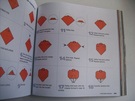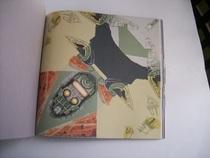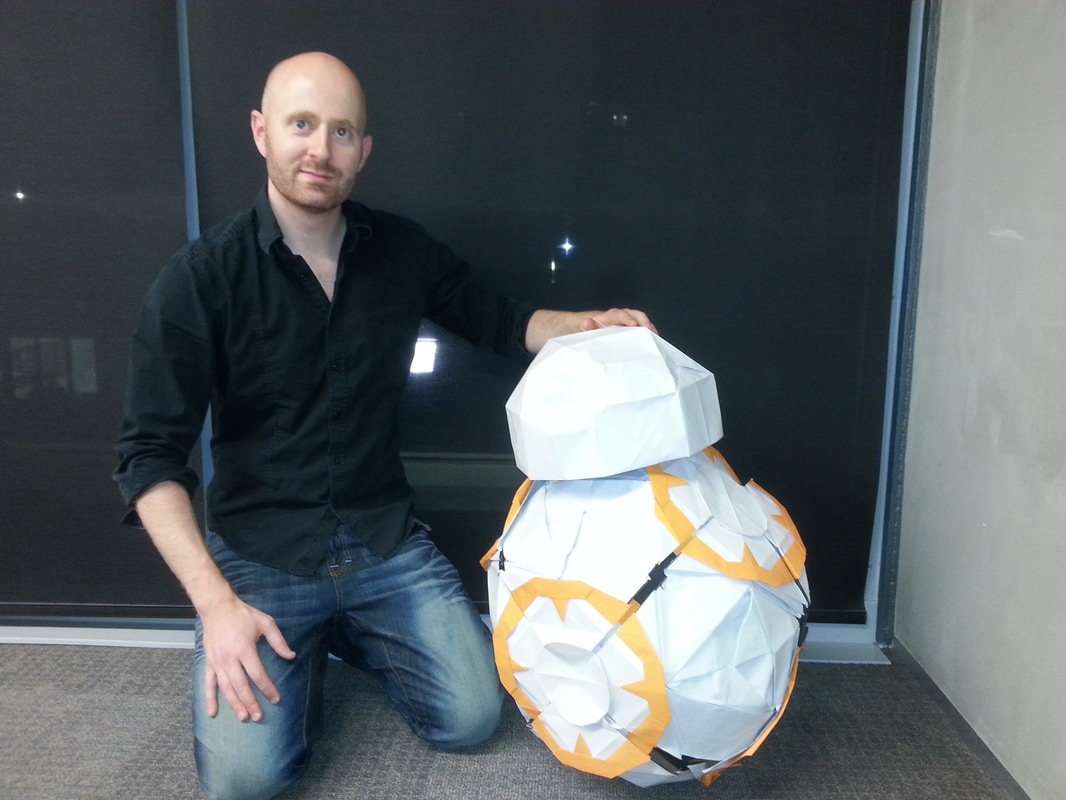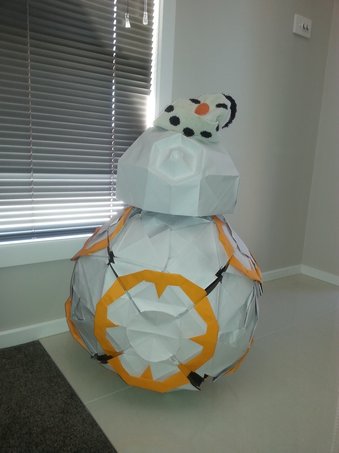| Way back in June last year, I was invited to be a guest speaker at the 37th National Sci-Fi & Fantasy Convention in Wellington. The organisers gave me a 1 hr slot, and wanted me to teach the attendees how to fold one of my models. Now this presented me with a challenge, in that my models tend to be complex, and often take far longer than an hour to fold, let alone teach to a room full of origami novices! My solution to this was to teach one of my modular designs - each piece is fairly simple, and with teams of people working together the complete model can be made within the allotted time - but to make an event of it, I decided to go big... Armed with 16 pre-creased sheets of 75cm square of poster paper, me and the team folded all the necessary modules, and I spent the next two hours carefully assembling all the parts - only to have it collapse in on itself in the final stages! So I jerry-rigged some internal supports from cardboard tubes and started again, this time taping all the locking folds in place, and finally, just in time to be unveiled at the closing ceremony, BB-8 stood tall under his own weight. The ball measures 50cm across, and the head is 30cm in diameter, almost 1:1 with the movie prop used during filming | Diagrams for all 4 modules are available for free download |
|
8 Comments
One year ago today, I posted this article about what the future may have held for my origami designs - 12 months on, it's time for a short retrospective to look back and see what I have actually accomplished during this time... As of today, where I'm putting the finishing touches to my new Snowspeeder design, I have created 10 new models featuring designs from both the original trilogy and the prequels
That's 4 new designs from the original trilogy, and 6 more from the prequels, designed in 4 separate creative bursts separated by several months of down time. Looking now at the * ratings I assigned last year, I've had a 70% hit rate knocking off high priority items, getting that much closer to having the level of content needed to attract the interest of the Lucasfilm licensing department
So what does the To-Do list look like now?
Still plenty to be getting on with! Even though I'll probably only focus on the 6 theatrical movies, it's good to know I'm not going to be short of source material for a while. With the upcoming "Rebels" TV series and Episode VII on the way, it's unlikely I'll ever wanting for inspiration - so sit back, and see what the next 12 months bring!
Thanks to my good friends at Jedi News, I've been given the opportunity to attend Star Wars CEII in Germany at the end of the month, and display my models to thousands of Star Wars fans from around the globe.
This is a fantastic chance for me to get more exposure and more support, maybe even meet some contacts who can help point me in the right direction with regards to securing that elusive license and publishing deal! Stay tuned for more updates as I've finally got around to recording the video walkthrough for my diagrams of the Gungan Sub - better late than never! Starwarigami now has its own channel on YouTube where I will be uploading video tutorials to fold some of my models. First up, my big hairy man hands get to work on the Naboo Starfighter...  As many of you may know, I'm not the only Star Wars Origami artist out there. Chris Alexander, of starwarsorigami.com, has been folding his own original designs for at least as long as I have, and in August this year he finally realised his dream of seeing his designs in print. Now this is a fantastic achievement after many years of hard graft, and one I also hope to repeat, so I bought a copy of the book to show my support, and check out the competition... The book itself is gorgeously presented. It has a glossy metallic cover and good quality paper throughout which lends it a nice satisfying weight. The book opens with a foreword by Tom Angleberger, author of the The Strange Case of Origami Yoda series of childrens books, followed by an introduction from the author and a section introducing the basics of origami, which explains the terminology and symbols used in the diagrams that follow.  Throughout the book, interspersed between the diagrams are full colour stills from all six movies, and each model has a double page introduction, with a large image and a paragraph of descriptive text about the vehicle or character being folded, and a clear image of the final model. Between every few models, there's a brief Star Wars trivia quiz testing your knowledge of the films, which is a nice addition and adds a welcome extra layer of interest to the book  The diagrams themselves are very clear and concise, with 9 images to the page throughout, clearly numbered. Some steps are broken down more than strictly necessary, but given the target audience for the book, both children and Star Wars fans who are not necessarily familiar with origami, this seems like a sensible idea, and experienced folders will breeze through them in no time.  At the back of the book, we find one of its key selling points - 72 sheets of pre-printed paper, matched to each of the 36 models in the book. This paper is thinner than the pages of the book proper, similar to genuine origami paper in thickness, and is perforated along the spine for easy removal. The graphics on these sheets greatly enhance the rather simplistic models, and tie them back to the Star Wars universe in a neat an original way. This is not something that will appeal to origami purists, but for children this adds a cool extra dimension to the play value of these models. The ModelsEach of the 36 designs is placed in one of four difficulty categories based on its ease of folding:
Now these rankings should be taken with a pinch of salt. While the models do lie on a sliding scale of complexity, there is nothing in this book that will challenge someone with more than just a passing familiarity with origami - even the most complicated of the designs can be folded in less than quarter of an hour - but this is not necessarily a bad thing. Given the target audience, the range of models is pitched pretty well, and there is plenty in here to keep kids occupied for hours on end as they progress through the difficulties. The full list of models is as follows. (The number of sheets is indicated in brackets if the model requires multiple pieces)
However, these few designs that don't sit well with me appear to be some of his earlier creations - over the years that Chris has been designing his own models, it's apparent that his skills with the paper have been improving greatly, which is evident in some of his more recent creations. The Naboo Star Skiff was a delight to discover, and can't really be bettered at this level. Luke's Landspeeder is also charming, sharing many similarities to my own design, and the complexities of what is probably his most challenging design, Slave I, provide a fitting goal for the reader to work towards. Even the Naboo Starfighter, while not really capturing the sleek and graceful curves of the actual ship, comes together as a nice little model and is a satisfying fold in its own right. Final thoughts...So would I recommend this book? Yes, most wholeheartedly.
For any kids who love Star Wars, this book should be a must have. Folding these models with them would definitely be a great bonding activity, and a fantastic way to spend some quality time with them. There is a good range of difficulties throughout the book, which should keep them interested for more than a single afternoon, and the pre-printed sheets are a wonderful way to get their attention. But is this book suitable for adults? Again, I would have to say yes. The models may be a little simplistic, but that is part of the charm. To put it in perspective, the most complicated of Chris' models takes the same amount of time as the simplest of my designs, and even those which aren't to my personal taste are still instantly recognisable to even the most casual of Star Wars fans. So if you want to be able to whip something up during a boring meeting at the office, or in the pub to impress your mates over a beer, this is the book for you - after all who really has 2 and a half hours to sit down and fold R2-D2 in this day and age? (Actually, I guess we've all had one of those meetings...) And last but not least, for purely selfish reasons, if you ever want to see my designs in print, this book has to be a success - a publisher is unlikely to take a risk on an Advanced Star Wars Origami book if the beginners book doesn't sell well! You can order a copy from Amazon, or pick it up at any good book store People often ask me what my next model will be - the fact is, I never can say with any certainty. Sometimes, if inspiration strikes, I can sit down and design a new model on the first attempt, such as the Hailfire Droid or Naboo Starfighter. Other times I'm trying for one model and end up with the paper leading me in a completely different direction - the Trade Federation Landing Craft was originally intended to be a Vulture Droid! And then there are those models that persist in eluding me completely. I've had numerous attempts at a Slave 1, Y-Wing or A.T.S.T., but have yet to find an approach for any of them that even comes close. The X-Wing was another model I had to revisit several times, and it took 5 years from my first attempt to come up with the final model shown on the site today. A trawl through wookieepedia gives a list of possible models I could consider making - There are some that I feel are absolute must-haves for the book, that are too iconic to leave out, and others which are not distinctive enough to warrant their own unique designs. I've marked up what I think my priorities should be, but feel free to let me know in the comments anything I may have missed or that you think I should bump up the list!
As a child, my only exposure to origami were the playground folds that everyone learns at school - the flapping bird, the fortune teller, the paper boat - great fun for kids, but that was all.
It wasn't until I was at university that I opened up the doors to the amazing number of possibilities that were out there to completely transform a humble piece of paper. I picked up a book of origami as a cheap way to pass the time between lectures, and jumped straight in with the most advanced book I could find in the shop at the time - Robert Lang's Complete Book of Origami. I struggled with some of the models at first, having dived straight in at the deep end, but my Maths degree stood me in good stead and I quickly picked up a rudimentary understanding of the techniques involved. After breezing through several more of Lang's books and most of John Montroll's back catalogue, my thoughts turned to designing a few model's of my own. It was around the same time of the theatrical release of The Phantom Menace, so my mind, like many others round the world was filled with all things Star Wars. It was only natural then, that my first foray into origami design would also follow suit. The resulting model, an X-Wing folded from the traditional frog base, was nothing special, and it would be a ship I revisited time and time again, but it set me on a path that leads all the way to the present day. For a few years, I came up with new models on a regular basis - the Millennium Falcon was the first of the current generation of models to see the light of day, quickly followed by the Star Destroyer, which was born from a bus ticket during a particularly long traffic jam! But by 2004, with my student years a distant memory, real life was beginning to take hold. A new job, a new city, a mortgage, marriage, and a brief flirtation with cancer, all conspired to put my dream of publishing a book of my own origami design on hold, indefinitely... ...until, at the end of 2011, a spur of the moment decision to attend a meeting of the British Origami Society, wound up with me agreeing to fold some large scale version of my designs for display at the London MCM Expo. The positive feedback I received at this event rekindled my passion, and I resolved to go all out to make that dream a reality. I set up facebook and twitter accounts to gauge the public interest, and a new improved website followed in short order. Obviously, with the long-awaited release of Chris Alexander's Star Wars Origami book, I've been beaten to the punch. But I sincerely believe there is room on the market for a more detailed and grown-up approach to the material to also be a success, and with enough support, I'm sure I'll be able to convince Lucasfilm to give me the chance to prove it! Welcome to Starwarigami 2.0!  Is this the droid you're looking for? A long time ago, in a galaxy far far away... In 2001, I created my first origami X-Wing. Over the next few years several new models followed, and then... nothing. After many years languishing in internet limbo, unfinished, unloved and abandoned, starwarigami.co.uk finally gets a long overdue facelift. A chance to display my models at a couple of high-profile exhibitions earlier in the year was the motivation I needed to reinvest myself in bringing my designs to the widest possible audience. In the age of Web 2.0 and the social media revolution, there's no place for hand crafted html, scrolling marquee text, mspaint graphics and comic sans font, not to mention blank content pages and dead links! Thanks to the creative minds at Word Gets Around and powered by weebly.com we are now up and running with a new look, ready to take our first steps into a larger world. The new site is still a work in progress, so there will be a number of changes going on even though we have gone live, so please be patient during this transition period, and feel free to let me know if you find any problems, or have any other feedback. Alongside this site, you can also find me on facebook and flickr, and follow me on twitter to stay up to date with the latest and greatest goings on in the exciting world of star wars origami:
The saga continues...
|
Flickr UpdatesTwitter LatestBlog Archives
February 2017
Categories |




 RSS Feed
RSS Feed
